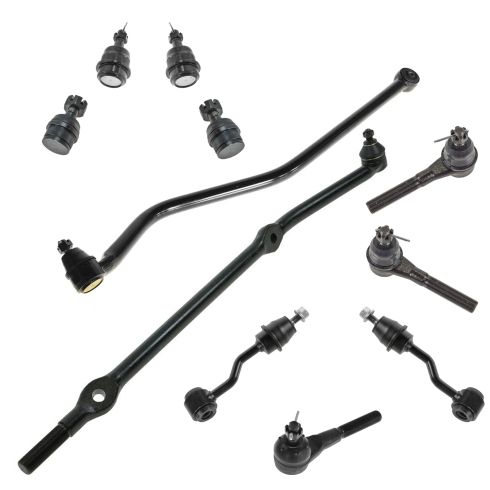1ASFK01088-1996-98 Jeep Grand Cherokee L6 4.0L 4 Wheel Drive Front 11 Piece Steering & Suspension Kit TRQ PSA58717

Replaces
1998 Jeep Grand Cherokee L6 4.0L 4 Wheel Drive Front 11 Piece Steering & Suspension Kit TRQ PSA58717

Product Reviews
Loading reviews
4.31/ 5.0
13
13 reviews
Just perfect
September 17, 2017
Item exactly as described, fits perfectly, my jeep is on the road again!!!
Very happy
November 4, 2017
Was a little nervous, considering the price but the parts were high quality and fit perfectly. Drives like it's new!
PERFECT FIT
April 27, 2018
Fit perfect, was shipped promptly. Had no installation problems.
Very light duty
April 30, 2018
This is something to consider if you need to stretch a buck-- as I did.
Parts are fine and function, but are nothing to praise.
Oh- non-serviceable by the way.
Great product
May 19, 2018
Fantastic quality customer service out of this world ups lost/destroyed first shipment A1 was on it and sent out another no charge great product fixed death wobble! Would buy again and again A++++++++++
Jeep front end parts
November 13, 2018
Seems like a good quality kit. Havent had a chance to get installed yet but everything looks good. Was simple to find what I needed on the website.
Didn't quite get what I ordered
February 26, 2019
Package arrived with a hole in it (shipping fault) and missing parts. The left tie rod was for a Cherokee not a Grand Cherokee. Ball joints didn't quite fit right so I had to buy new. One lower ball joint was bad right out of the package.
Great value
April 16, 2019
Installed parts before driving 1700 miles one way to visit family and back with some wheeling in between. Aligned my front end myself with scrap angle iron, step straps and two tape measures. Has outperformed my expectations so far. Couldnt see ever buying parts any other way when possible. Gotta love getting better value without sacrificing performance. Well done 1A Auto!
Ball joint and tie rod replacement
July 2, 2019
I highly recommended! Every steering component in one easy order! Replaced everything in 10 grueling hours, but saved 900 on parts and labor. This web site is the best!
Jeep Grand Cherokee
August 21, 2020
bottom ball joints didn't fit properly all the tie rods wasn't in there missing Carter pins some castle nut got stripped just poor quality
July 5, 2021
Better deal then i thought it was going to be bit parts are perfect ty
Great products, Dynamite service!!
December 21, 2021
Good service, great quality parts! Other than a delivery issue (no fault of 1Aauto), parts came brand new still in plastic!!
Thank you for having such a great inventory of car parts at prices better than the local auto stores!
June 5, 2022
Perfect fit
Customer Q&A
Will it fit my 2wd?
April 24, 2018
10
No this will not fit a 2 wheel drive model.
April 29, 2018
T I
10
No
May 10, 2018
J O
10
No
May 10, 2018
J O
10
Will not fit 2wd
June 25, 2018
B R
10
Yes it will! Just did a change out on my 4.0 rwd
July 2, 2019
R O
10
Yes that is what I have
July 30, 2020
T R
10
yes
August 24, 2020
B R
10
Yes
January 28, 2021
Lamont S
10
Yes
April 6, 2021
K J
Ok there are conflicting answers on whether it fits 2we as well as 4wd, so is it yes or no. I need one for a 2wd?
October 19, 2019
10
Hello Steve,
This kit will only fit 4wd models. If you have any other questions feel free to contact us and have a great day.
Thank you,
Corey
October 19, 2019
Corey M
10
Thank you for the inquiry. We do not currently carry a steering and suspension kit for the 2WD 1996-1998 Jeep Grand Cherokee. We're always updating our inventory so please check back soon! If you have any other questions, let us know.
October 21, 2019
Christa R
Will this fit a V8 model Grand Cherokee?
November 30, 2019
10
Thank you for contacting us. This kit is not listed to fit that vehicle. It is listed to fit the following:
1996-1998 Jeep Grand Cherokee L6 4.0L 4 Wheel Drive Steering & Suspension Kit 11 Piece Set
November 30, 2019
Peter L
Jeep is a registered trademark of FCA US LLC. 1A Auto is not affiliated with or sponsored by Jeep or FCA US LLC.
See all trademarks.
















